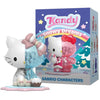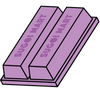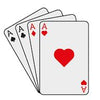Beginner's guide to Japanese bento
Bento box is a practical way for many Japanese people, from schoolchildren to politicians, to have their packed meal. Japan bento boxes have gained a reputation as a nutritious, well-balanced, and visually appealing lunch on the go that is almost as well-known as sushi and ramen. Japanese bento boxes contain a tasty, vibrant, fresh, and nutritious meal such as rice, main dish(usually meat), and several side dishes. But a bento is more than simply a packed lunch to eat. For Japanese, there is a ton more whole it. Bento box lunches address various food-related matters, including nutrition, flavor, texture, preservation, and presentation.

Well-designed bento lunch boxes should be a full lunch pack with various flavors, textures, and food groups. The authentic Japanese cooking methods are known to be very detailed and useful in every available inch of space, and preparing lunchboxes are no different. The attention to detail and the harmony of the components set it apart from the ordinary packed lunch. The food is neatly and firmly packed into a small square or rectangular shape, so everyone can enjoy a variety of foods while consuming all the nutrients necessary for a healthy lifestyle. Making your own bento may initially seem a daunting task as it takes so much time and works to make them appear so good and interesting to eat. Yet, it doesn't necessarily need to be that way. Here's a beginner guide to Japanese bento.
History of Japanese bento lunch boxes

Since the 5th century, the bento box has been a mainstay in Japan's culinary history. The multi-compartment farmers' seed box inspired the classic compartmental design of bento lunches. Traditionally composed of woven basket material or lacquered wood, the design took on an opulent twist in 1912 with the debut of aluminum bento boxes. By the 1980s, the bento box had become popular in Western culture because of people's rising adoration for convenient food to eat easily without a mess. Then in the 1990s, the character bento was introduced. And presently, bento-style lunchboxes have once again gained popularity as a waste-free lunch option due to rising concerns about environmental sustainability and human health.
What's inside Japanese bento boxes?

Bentos come in a variety of sizes and shapes. They are a complete Japan lunchbox with one serving of well-balanced, flavorful, healthy foods to eat. Each food variety is neatly arranged inside the box, carefully thought out to prevent the different dishes from mixing. Some have frequently employed little separators or silicone cups. Anything can be placed within a bento box, but rice, the primary component of Japan's cuisine, is frequently included. Otherwise, as long as it is properly balanced, other foods and any healthy lunch dishes of choice can be put in it.
Typical ingredients in a Japanese bentos are:
-
Meat or fish (usually in the form of meatballs, raw fish, karaage, katsu, sausages, hard boiled egg, etc.)
-
Colorful vegetables that have been fried or pickled (Salad, broccoli, carrots, bell peppers, cucumber slices, bean sprouts, edamame, cherry tomatoes, shiso leaves etc.)
-
Tamagoyaki (Japanese rolled omelette)
-
Potato salad or sometimes fruit (in a little box or small bowl)
You can use any combination of white rice or brown rice with meat, seafood, hard boiled eggs, beans, or tofu as the primary protein. Side dishes include fruits, vegetables, dumplings, pickles, seaweed, desserts, fried chicken, etc.
Types of Bento Boxes
Bento comes in a variety of forms, each with a specific function and setting. These boxes do not just appeal to our eyes for their aesthetic appearance, our stomachs for their nutrients and flavor, but also our hearts and minds for their cultural significance to the Japanese. These bento box varieties are the most popular in Japan:
Hinomaru bento
The most basic type of bento is also a fitting lunch option for Japanese food. Hinomaru, which translates to "circle of the sun," conjures up images of Japan's flag. This bento's two major ingredients are a side dish of fish or pork and rice topped with a single red umeboshi (pickled plum). Plum is a natural preservative that keeps the dish fresh and represents the red dot on the Japanese flag.
Makunouchi bento
This is the typical lunchbox sold in supermarkets, convenience stores, and department stores. It is safe to assume that Japanese workers currently consume it during their break between the morning and afternoon shifts.
Aisai bento
Japanese women frequently make this type of bento, which literally translates to bento cooked by loving wives. This bento, which a wife would prepare for her husband to bring to work and serve to them while he is away, would serve as a reminder of home.
Kyara-ben
This is the most well-known variety of bento due to its "kawaii" appearance. Food is imaginatively chopped and arranged to create a visual feast, often taking influence from characters from anime, manga, video games, or cartoon shows. With the use of cut fruits and vegetables, you can see figures like Pikachu, Totoro, and Gundam.
Ekiben
These premium lunchboxes, which combine the terms eki (train station) and bento, are sold at significant railway stations on the platform and inside the cars. The ekiben is a whole bento with a set of disposable chopsticks in a box made of plastic, wood, or porcelain. Usually, the lunchbox contains local staple foods as its ingredients.
How to make bento?

Making bentos are fantastic since you can customize them. They can be kept straightforward by including an omelet roll and some cooked rice, or they can be made a little spicier by including sushi, sashimi, and much more delicious food. Any additional items you choose to include in your bento will make it a wonderful way to carry a tasty Japan taste lunch. However, the idea of making your own bento may seem difficult if you've never done it. With these easy tips, you'll be a pro in no time.
-
Start with the right bento lunchbox.
To make bento, selecting the right lunchbox is important. The lunch will be packed in a lunchbox that can be as fancy or as simple as you prefer. You can select from various bento box styles and brands at various pricing points.
-
Plan.
You'll learn how simple it is to make a nutritious lunch pack that you, your kids, and your family can enjoy five days a week with little meal prep and planning. Making an additional serving of your evening meal so that you have leftovers to pack in your bento the following day to save time may be all that's necessary in terms of bento planning. Easy!
-
Cool before being sealed.
Allow certain foods to cool to room temperature if they are warm or hot before sealing the box with your bento. The foods in a bento are intended to be eaten after a few hours at room temperature to still taste good. Bacteria and undesirable condensation can result from trapped steam, especially in stir-fried and dry foods.
-
Think of textures.
The bento's attention to how the variety of meals complement one another and look is part of what makes it so brilliant. To create a well-rounded meal experience, combine soft ingredients like rice or different vegetable types with crispy and crunchy ones like senbei or fried rice balls.
-
Color.
Half of the pleasure of bento is its aesthetic appearance: add color to more subdued dishes by arranging them next to colorful ones, or use decorative nori pieces that you've punched out to attach to colorful pieces of fruit and vegetables.
Best Japanese bento box
Japan offers a huge selection of options for bento boxes. Available in various sizes, shapes, and materials. Additionally, numerous style options suit every preference, including lovely traditional Japan-inspired designs, anime characters, contemporary simplicity, and more. Additionally, portable cutlery like chopsticks, forks, and spoons are included in some bento boxes. You might choose a different set to go with your bento box or find ones that match it. The Japanese bento box market is large, so you'll have a lot of options to select from. Check these bento boxes, from a tightly packed wooden two-layer bento box to a limited edition lunch box that will keep your food safe and in style.
Additionally, it would be best to have a bento lunch bag to transport your bento. There are other options for these as well. Most of them are constructed of fabric. Some, particularly during the summer, are insulated or contain pockets for an ice pack to keep food cool and be eaten cold. You may add various accessories to your bento boxes for usefulness and aesthetic appeal. Many kitchen utensils, soy sauce containers, thermal lunch jar, bright little bowls, skewers, some small cookie cutters shaped like fruits, animals, or other adorable things perfect for your Japanese cooking bento experience are available in Sugoi Mart. Japanese bento culture and great tips will help you develop healthier eating habits and make lunchtime more enjoyable for everyone. Enjoy!















































































Leave a comment